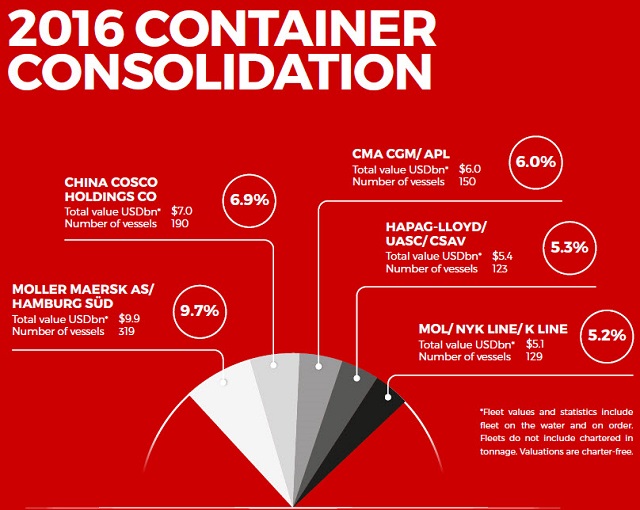Hapag-Lloyd Enters Post-Panamax Market
Hapag-Lloyd has held a naming ceremony for the Valparaíso Express, the first of five new vessels in its new 10,500 TEU class.
The ceremony was held at the Terminal Pacifico Sur (TPS) in the port of Valparaíso, Chile, where the new ship will call regularly. As the first vessel in the new Valparaíso Express class, she will sail in the revised Europe – South America West Coast service of Hapag-Lloyd.
Four of the five newbuildings are replacing older Panmax ships on the service, while a second Panmax size loop (SW2) and two slot charter agreements (EW1 and EW2) in the same trade lane will be terminated.
“The entry into the Post-Panmax ship class in this trade lane is ensuring that Hapag-Lloyd stays competitive as one of the market leaders after the expansion of the Panama Canal,” said Anthony J. Firmin, Chief Operating Officer at Hapag-Lloyd. “South America and especially Chile are very important markets for us, and we will be able to serve particularly our reefer customers much better with the new ships.”
The roundtrip of the Valparaíso Express will take nine weeks with a port rotation of: Rotterdam, London, Hamburg, Antwerp, Le Havre, Caucedo, Cartagena, Manzanillo (Panama), Buenaventura, Callao, Puerto Angamos, Valparaíso, Callao, Buenaventura, Manzanillo (Panama), Cartagena, Caucedo and Rotterdam.
The second vessel from the series ordered in April 2015 has been now delivered to Hapag-Lloyd by Hyundai Samho Heavy Industries in South Korea. The remaining three ships are due for delivery by April next year.
All five ships will sail under the German flag and are classified by DNV GL. They are 333 meters long and 48 meters wide (maximum 19 rows of container side by side) and have a maximum capacity of 123,500 tonnes with a maximum draft of 14 meters. From keel to superstructure they measure a height of 63.5 meters. The eight cargo holds (9 tiers of containers) and decks (9 tiers of containers) feature a total capacity of up to 10,593 TEU including 2,100 plugs for reefer containers.
Container Shipping Consolidation
Hapag-Lloyd completed its integration of Chilean line CSAV earlier this year. In July, the company continued its growth by signing a merger agreement with UASC. The new merger will bring Hapag-Lloyd's average age down to 7.8 years from 8.7 years, reports VesselsValue.com. Hapag-Lloyd and UASC combined will be the fourth most valuable fleet up from tenth and eighth, respectively.
Maersk has now confirmed that it will acquire German container shipping line Hamburg Süd. Hamburg Süd's strong position in north-south trades will complement Maersk's current business. Maersk is thought to have paid roughly $4 billion for Hamburg Süd whose fleet is worth $1.5 billion, says William Bennett, senior analyst at VesselsValue.com. The deal is expected to be complete by the end of 2017. Entry of Hamburg Süd into the 2M alliance will put the alliance into the lead with 15 percent of global capacity.
The Chinese state cabinet approved the merger of COSCO and China Shipping back in December of 2015. The merger is a part of plans to create stronger, larger national entities that have greater competitive advantage and prevents the two lines from competing against one another. China COSCO Holdings have the largest fleet on order with 29 ultra-large container ships and four Post-Panamax container ships. The Chinese owned container fleet is the most valuable at $17.6 billion and accounts for around 17 percent of the market, says Bennett.
CMA CGM acquired Singaporean company, NOL, best known for its APL brand earlier this year. Recently, it was also confirmed that APL would join CMA CGM in the Ocean Alliance which will subsequently represent 14 percent of global container capacity, second only to the 2M alliance. The acquisition will make the combined fleet the third most valuable in the industry.
One of the more recent mergers to be announced is that of MOL, NYK and K Line. Only the container businesses of these companies will merge and the consolidation is expected to be complete by 2018. The most valuable Japanese container fleet is Shoei Kisen valued at $3 billion and ranked eighth. In comparison, none of the other Japanese entities feature in the top 10 most valuable container fleets. The merger shows that consolidation can be used very effectively in the container industry to create a large footprint with only mid-size lines, says Bennett. The new arrangement makes the merged entity the fifth most valuable at $5.1 billion.

